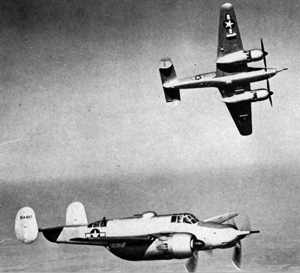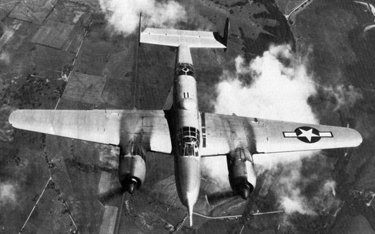Beechcraft XA-38 Grizzly




In 1942 Beech Aircraft had already started work on the design of a "bomber destroyer" aircraft, when the Army expressed an interest in developing a similar concept as a potent ground attack aircraft (as a replacement for the Douglas A-20 Havoc), to attack tanks, bunkers, and other hard-to-kill targets. The Beech design was already known as the Beechcraft Model 28 and had been given the name "Destroyer". In December 1942 the Army awarded Beech a contract to build two prototypes, under the designation XA-38. The name was changed to "Grizzly" soon after construction was begun. The Grizzly packed a formidable punch, with a 75mm cannon (with 20 rounds of ammo) sticking out of its stream-lined nose, as well as two nose-mounted .50 caliber machineguns, and a pair of .50s in each of the remotely controlled ventral and dorsal turrets. These turrets were controlled by a gunner using periscopic sights (similar to those used on the B-29) from the glassed-in observer's station in the aft fuselage. First flight of the initial prototype took place on May 7, 1944. Performance tests by the Army Air Corps were held through 1944 and 1945, with the results being as good or better than expected in most respects, including speed. There is even a story that the Grizzly "ran away" from a P-51B Mustang that was being used as a chase plane. Gunnery tests proved the effectiveness of the heavy armament, and serviceability was praised as well. Had the war continued it is probable that - with its speed, firepower, and rugged construction - the A-38 would have become the Army Air Force's most important attack bomber. However, by this time it was 1945, and it was becoming obvious that, not only was the war coming to an end, but so was the day of the piston engine. In addition to this, the engines for the Grizzly were the same as those used in the B-29, and the few engines that were not slated for that bomber were usually given to the new Douglas BT2D-1 and Martin Mauler aircraft programs. The program ended with only the two prototypes being built, with one being scrapped in the forties, and the other being slated for display in the Air Force Museum, but disappearing, never to be seen again. The Grizzly remains a minor footnote in U.S. aviation history, as well as one of the most tantalizing "might-have-beens" of the war.USAF archives on this aircraft, click here.
Beechcraft XA-38 Grizzly
Type: bomber interceptor / ground attack
Crew: 2, pilot and gunner
Armament: one T15E1 75mm cannon (w/ 20 rounds)
six .50 caliber machine guns (two in the
lower forward fuselage, 2 each in the
ventral and dorsal remotely controlled
turrets)
up to 2,000 lb of external stores
Specifications:
Length: 51' 9"
Height: 13' 6"
Wingspan: 67' 4"
Wing area: 626 sq. ft
Empty Weight: 22,480 lb
Max Weight: 32,000 lb max at takeoff
Propulsion:
No. of Engines: 2
Powerplant: Wright R-3350-53 radial
Horsepower: 2700 hp each
Performance:
Range: 1070 miles (with 2000 lb. load)
Cruise Speed: 344 mph
Max Speed: 376 mph at 4,800 feet
Ceiling: 27,800 ft
Source: Air Classics magazine, August 1983
If this page does not have a navigational frame on the left, click HERE to see the rest of the website.